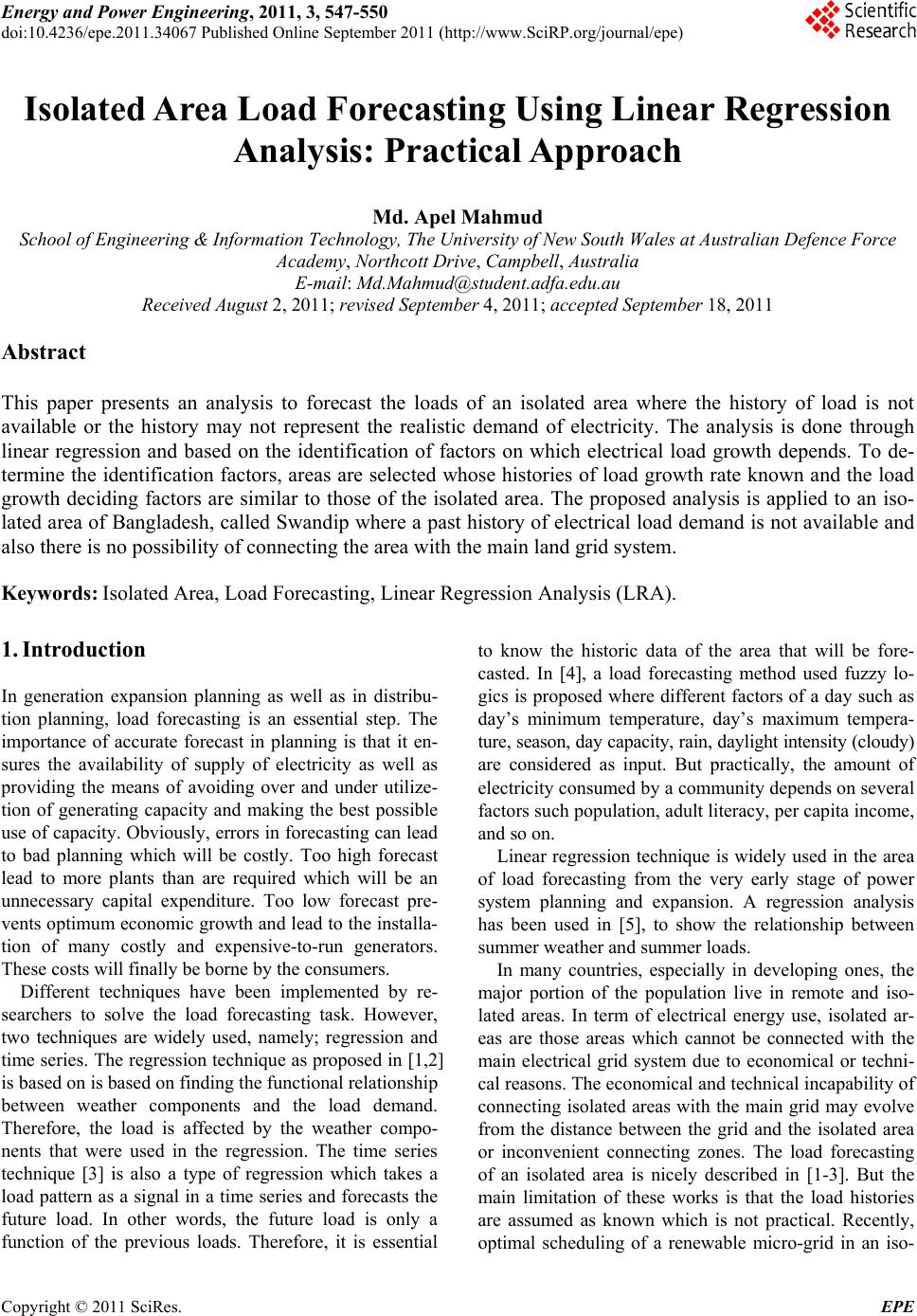
Energy and Power En gi neering, 2011, 3, 547-550
doi:10.4236/epe.2011.34067 Published Online September 2011 (http://www.SciRP.org/journal/epe)
Copyright © 2011 SciRes. EPE
Isolated Area Load Forecasting Using Linear Regression
Analysis: Practical Approach
Md. Apel Mahmud
School of Engineering & Information Technology, The University of New South Wales at Australian Defence Force
Academy, Northcott Drive, Campbell, Australia
E-mail: Md.Mahmud@student.adfa.edu.au
Received August 2, 2011; revised Se pte m ber 4, 2011; accepted Septembe r 18 , 20 1 1
Abstract
This paper presents an analysis to forecast the loads of an isolated area where the history of load is not
available or the history may not represent the realistic demand of electricity. The analysis is done through
linear regression and based on the identification of factors on which electrical load growth depends. To de-
termine the identification factors, areas are selected whose histories of load growth rate known and the load
growth deciding factors are similar to those of the isolated area. The proposed analysis is applied to an iso-
lated area of Bangladesh, called Swandip where a past history of electrical load demand is not available and
also there is no possibility of connecting the area with the main land grid system.
Keywords: Isolated Area, Load Forecasting, Linear Regression Analysis (LRA).
1. Introduction
In generation expansion planning as well as in distribu-
tion planning, load forecasting is an essential step. The
importance of accurate forecast in planning is that it en-
sures the availability of supply of electricity as well as
providing the means of avoiding over and under utilize-
tion of generating capacity and making the best possible
use of capacity. Obviously, errors in forecasting can lead
to bad planning which will be costly. Too high forecast
lead to more plants than are required which will be an
unnecessary capital expenditure. Too low forecast pre-
vents optimum economic growth and lead to the in stalla-
tion of many costly and expensive-to-run generators.
These costs will finally be borne by the consumers.
Different techniques have been implemented by re-
searchers to solve the load forecasting task. However,
two techniques are widely used, namely; regression and
time series. The regression technique as proposed in [1,2]
is based on is based on finding the functional relationship
between weather components and the load demand.
Therefore, the load is affected by the weather compo-
nents that were used in the regression. The time series
technique [3] is also a type of regression which takes a
load pattern as a signal in a time series and forecasts the
future load. In other words, the future load is only a
function of the previous loads. Therefore, it is essential
to know the historic data of the area that will be fore-
casted. In [4], a load forecasting method used fuzzy lo-
gics is proposed where different factors of a day such as
day’s minimum temperature, day’s maximum tempera-
ture, season, day capacity, rain, daylight intensity (cloudy)
are considered as input. But practically, the amount of
electricity consumed by a community depends on several
factors such population, adu lt literacy, per capita inco me,
and so on.
Linear regression technique is widely used in the area
of load forecasting from the very early stage of power
system planning and expansion. A regression analysis
has been used in [5], to show the relationship between
summer weather and summer loads.
In many countries, especially in developing ones, the
major portion of the population live in remote and iso-
lated areas. In term of electrical energy use, isolated ar-
eas are those areas which cannot be connected with the
main electrical grid system due to economical or techni-
cal reasons. The economical and tech nical incapab ility of
connecting isolated areas with the main grid may evolve
from the distance between the grid and the isolated area
or inconvenient connecting zones. The load forecasting
of an isolated area is nicely described in [1-3]. But the
main limitation of these works is that the load histories
are assumed as known which is not practical. Recently,
optimal scheduling of a renewable micro-grid in an iso-